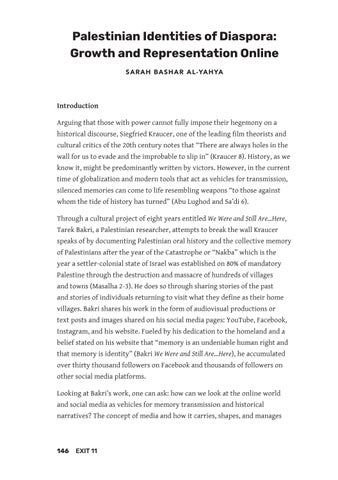Palestinian Identities of Diaspora: Growth and Representation Online SA R A H B A SHA R A L - YAH YA
Introduction Arguing that those with power cannot fully impose their hegemony on a historical discourse, Siegfried Kraucer, one of the leading film theorists and cultural critics of the 20th century notes that “There are always holes in the wall for us to evade and the improbable to slip in” (Kraucer 8). History, as we know it, might be predominantly written by victors. However, in the current time of globalization and modern tools that act as vehicles for transmission, silenced memories can come to life resembling weapons “to those against whom the tide of history has turned” (Abu Lughod and Sa’di 6). Through a cultural project of eight years entitled We Were and Still Are…Here, Tarek Bakri, a Palestinian researcher, attempts to break the wall Kraucer speaks of by documenting Palestinian oral history and the collective memory of Palestinians after the year of the Catastrophe or “Nakba” which is the year a settler-colonial state of Israel was established on 80% of mandatory Palestine through the destruction and massacre of hundreds of villages and towns (Masalha 2-3). He does so through sharing stories of the past and stories of individuals returning to visit what they define as their home villages. Bakri shares his work in the form of audiovisual productions or text posts and images shared on his social media pages: YouTube, Facebook, Instagram, and his website. Fueled by his dedication to the homeland and a belief stated on his website that “memory is an undeniable human right and that memory is identity” (Bakri We Were and Still Are...Here), he accumulated over thirty thousand followers on Facebook and thousands of followers on other social media platforms. Looking at Bakri’s work, one can ask: how can we look at the online world and social media as vehicles for memory transmission and historical narratives? The concept of media and how it carries, shapes, and manages
146
EXIT 11
